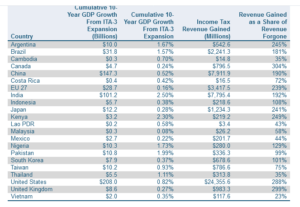Information technology is at the core of an ever-expanding range of products, but the Information Technology Agreement (ITA) — the trade agreement that eliminates tariffs on those products — hasn’t been updated since 2015.
Expanding it into what would be the “ITA-3” could cover more than 400 unique products, which would add $10.3 billion to Nigeria’s economy and more than $750 billion to the global economy over 10 years, according to a new report from the Information Technology and Innovation Foundation (ITIF), the leading think tank for science and tech policy.
“The ITA has been one of the World Trade Organization’s most successful agreements, spurring adoption of technologies that drive innovation and productivity across all sectors of the economy. Expanding the ITA would generate significant growth for all nations that participate,” said Stephen Ezell, vice president of global innovation policy at ITIF, who co-authored the report. “A further liberalization of tariffs for the rapidly expanding universe of technologies powered by information and communications technologies would help diversify and improve the resiliency of global supply chains, because it would bring more developing economies into the global technology ecosystem. The resulting growth would raise household incomes and support a continued expansion of technology jobs worldwide.”
Table 1: Summary of economic and revenue impacts over 10 years post ITA-3 accession
Originally signed in 1996, the ITA now has 82 countries as signatories. In 2015, 53 countries joined to expand the ITA, eliminating tariffs on an additional $1.3 trillion in global trade in 201 IT parts, components, and final products.
As technologies continue evolving, stakeholders have identified over 300 additional six-digit product codes under the Harmonized Commodity Description and Coding System as candidates for potential ITA inclusion, including over 400 unique IT products. The expanded product list could include high-definition televisions; energy-efficient technologies like storage batteries, solar cells, and LED light sources; digital manufacturing technologies like industrial robots and 3D printers; commercial-use drones; and medical technologies and devices, like patient monitoring systems; and semiconductor manufacturing parts and supplies.
ITIF’s report examines the economic and tariff revenue impacts an “ITA-3” would have for the European Union (EU) and 21 nations: Argentina, Brazil, Cambodia, Canada, China, Costa Rica, India, Indonesia, Japan, Kenya, Lao PDR, Malaysia, Mexico, Nigeria, Pakistan, South Korea, Taiwan, Thailand, the United States, the United Kingdom, and Vietnam. Among ITIF’s findings:
- India, Kenya, Pakistan, and Nigeria would see the largest relative GDP growth over 10 years—2.5 percent, 2.3 percent, 2 percent, and 1.7 percent, respectively—but all 22 countries would see larger economies over the timeframe.
- Most countries would see expanded economic growth from an ITA-3, producing more tax revenue over 10 years than would be forgone in tariff revenue.
- India, Kenya, Pakistan, Nigeria, Argentina, and Brazil are the largest beneficiaries of an ITA-3. While all nations benefit considerably, these seven nations experience the highest relative growth in real GDP due to an ITA-3 expansion.
- Countries not participating in the ITA saw their participation in global IT value chains decline by more than 60 percent from 1995 to 2009.
“Expanding the ITA to cover most cutting-edge IT products would produce considerable economic growth, exports, and jobs for the United States and the world,” said Trelysa Long, a policy analyst at ITIF and co-author of the report. “These products already deliver significant environmental, health, and production benefits. Nations would be wise to include them in an ITA-3 to bolster the growth and competitiveness of their own domestic industries.




